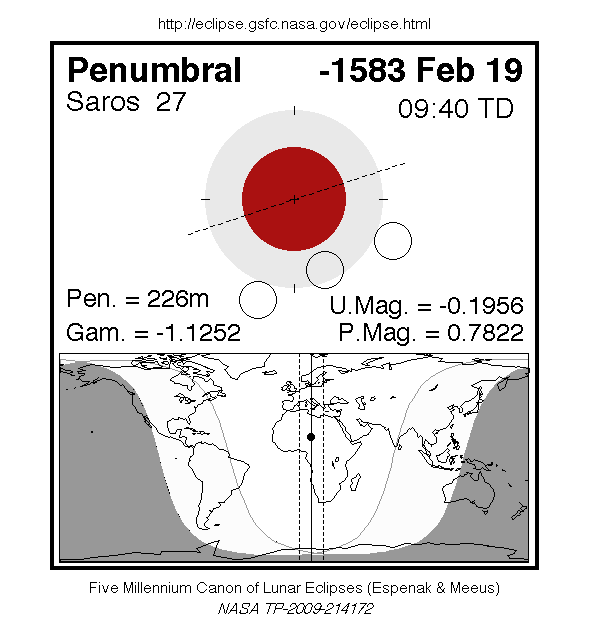A penumbral eclipse of the Moon occurred on 18 February, 1584 BC UT Old Style, with maximum eclipse at 23:25 UT. This subtle penumbral eclipse may have been visible to a skilled observer at maximum eclipse. 78% of the Moon's disc was partially shaded by the Earth (none of it was in total shadow), which caused a gentle shadow gradient across its disc at maximum; the eclipse as a whole lasted 3 hours and 46 minutes.
The penumbral eclipse lasted for 3 hours and 46 minutes.
Maximum eclipse was at 23:25:29 UT.
Overview Map
This map sourced from NASA Goddard Space flight Center: GSFC Eclipse Web SiteGSFC Eclipse Web Site
The primary source of all the information on eclipses presented here at Hermit Eclipse. (NASA Goddard Space flight Center)
shows the visibility of the eclipse. (Click on it for the
full-sized version.)
Eclipse Season and Saros Series
This eclipse season contains 3 eclipses:
This was the 20th eclipse in lunar Saros series 27.The surrounding eclipses in this Saros series are:
This Saros series, lunar Saros series 27,
is linked to solar Saros series 34. The
nearest partner eclipses in that series are:
Eclipse Parameters
| UT Date/time (max) | 23:25:29 on 18 Feb UT |
TDT Date/time (max) | 09:40:01 on 19 Feb TDT |
| Saros Series | 27 |
Number in Series | 20 |
| Penumbral Magnitiude | 0.7822 |
Central Magnitiude | -0.1956 |
| Gamma | -1.1252 |
Path Width (km) | |
| Delta T | 10h15m |
Error | ± 1h11m (95%) |
| Penumbral Duration | 3h46m |
Partial Duration | |
| Total Duration | |
| |
| Partial Rating | |
Total Rating | |
Note that while all dates and times on this site (except
where noted) are in UT, which is within a second of civil time,
the dates and times shown in NASA's eclipse listingsGSFC Eclipse Web Site
The primary source of all the information on eclipses presented here at Hermit Eclipse. (NASA Goddard Space flight Center)
are in the TDT timescale.
For this eclipse, this makes the date shown on this site
different to NASA's date.
Data last updated: 2015-06-21 22:11:39 UTC.

